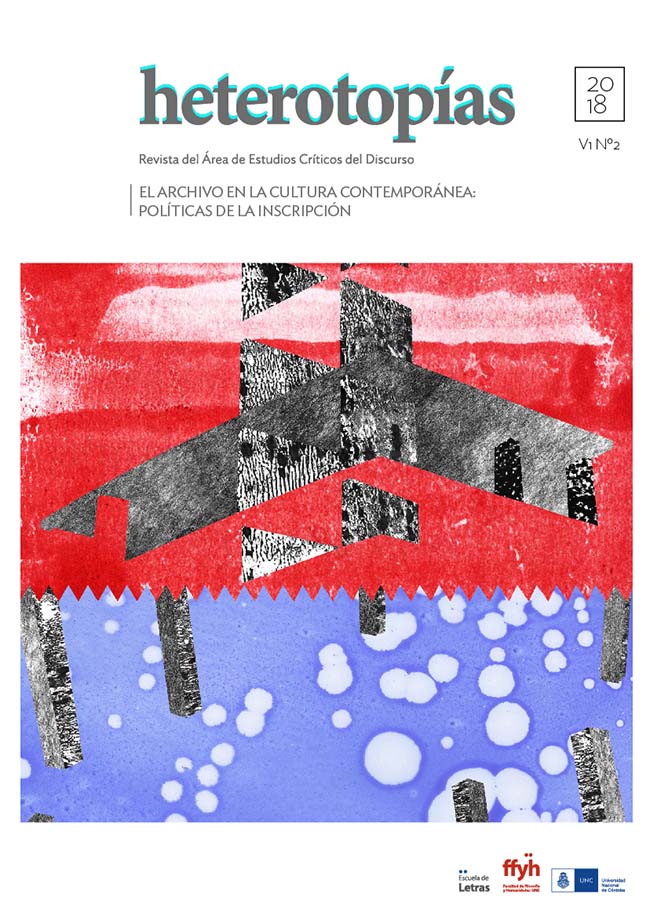Spatiality of time: from document’s declassification to counter-archive
Main Article Content
Abstract
Following scholars such as Hal Foster o Anna Maria Guasch we could recognize an archival turn that proposes new challenges to art history in general, but more precisely to the relationship between art and the couple history/memory, and the link that visual culture establishes with this paradigm settled for two decades as a generative mark of much of the artistic production. Actualizing Walter Benjamin’s and Aby Warburg’s concerns these pages try to think about the archive paradigm in relation to the exhibition En nuestra pequeña region de por acá (MALBA, 2016) of the Chilean artist Voluspa Jarpa who extremes the productivity of a notion that is not only the support of her work but the very essence of her positioning about memory, history and the ways of giving account of them. The exhibition draws from the CIA unclassified archives in fourteen Latin-American countries in order to think the relationships between politics, history and image. Archival logic requires its own way of reading, the deconstruction of the montage away from the legal-administrative logic and its own exploration of the aesthetic-politic potentialities as counter-archive.
Downloads
Article Details
Those authors who have publications with this journal, accept the following terms: Those authors who have publications with this journal, accept the following terms:
a. The authors will keep their copyright and guarantee to the journal the right of first publication of their work, which will be simultaneously subject to the Creative Commons Attribution - Non-Commercial - Share Alike (by-nc-sa) Attribution License; no commercial use of the original work or any derivative works is allowed, the distribution of which must be done with a license equal to the one that regulates the original work.
b. Authors may adopt other non-exclusive license agreements for the distribution of the published version of the work (e.g., deposit it in an institutional telematic archive or publish it in a monographic volume) provided that the initial publication in this journal is indicated.
c. Authors are allowed and recommended to disseminate their work through the Internet (e.g. in institutional telematic archives or on their website) before and during the submission process, which may lead to interesting exchanges and increase the number of citations of the published work. (See The effect of open access).
References
AA.VV. (2010). Arte minimalista. Estados Unidos 1960. En Grupos, movimientos, tendencias del arte contemporáneo desde 1945. Buenos Aires: La marca editora.
AGAMBEN, Giorgio. (2005). El autor como gesto. En Profanaciones. Buenos Aires: Adriana Hidalgo editora.
AGAMBEN, Giorgio. (2011). ¿Qué es lo contemporáneo?. En Desnudez. Buenos Aires: Adriana Hidalgo Editora.
BECKETT, Samuel. (1069). Detritus. Barcelona: Tusquets.
BENJAMIN, Walter. (2002). Dialéctica en suspenso. Fragmentos de historia. Santiago de Chile: Arcis Lom.
BERNINI, Emilio. (2010). Found footage. Lo experimental y lo documental. En Listorti, Leandro y Trerotola, Diego. Cine encontrado. ¿Qué es y adónde va el found footage?. Buenos Aires: Ediciones del Buenos Aires Festival Internacional de Cine Independiente.
BUCHLOH, Benjamin. (1999). Atlas/Archive. En Alex Coles (ed.). The Optic of Walter Benjamin, vol. III. Londres: Black Dog Publishing Limited.
BURTON, Antoinette. (2005). Archive Stories. Facts, Fictions, and the Writing of History, Durham y Londres: Duke University Press.
DERRIDA, Jacques. (1997). Mal de archivo: una impresión freudiana. Madrid: Akal.
DIDI-HUBERMAN, Georges. (2007). Das Archiv brennt. En Didi-Huberman, Georges y Ebeling (eds.). Das Archiv brennt. Berlin: Kadmos.
ENWEZOR, Okwui. (2008). Archive Fever: Photography between History and the Monument. En Archive Fever: Uses of the Document in Contemporary Art.
FOSTER, Hal. (2002). “Archives of Modern Art”. October, 99, 81-95.
FOSTER, Hal. (2004). “An Archival Impulse”. October, 110, 3-22.
FOUCAULT, Michel. (1969). L'Archéologie du savoir. París: Gallimard.
GIUNTA, Andrea. (2010). Archivos. En Objetos mutantes. Sobre arte contemporáneo. Santiago de Chile: Palinodia.
GIUNTA, Andrea. (2010a). “Archivos. Políticas del conocimiento en el arte de América Latina”. Errata, 1, 20-37.
GUASCH, Anna Maria. (2011). Arte y archivo 1920-201. Genealogías, tipologías y discontinuidades. Madrid: Akal.
HAGELSTEIN, Maud. (2016). « L’Atlas à l’épreuve de l’image en mouvement (Warburg, Farocki, Didi-Huberman) ». MethIS, 5. 151-173.
JARPA, Voluspa. (2014). « Historia, archivo e imagen : sobre la necesidad de simbolizar la historia ». A Contracorriente. Una revista de historia social y literatura de América Latina/A Journal on Social History and Literature in Latin America, vol. º1, Nº 1, 14-29.
MALRAUX, André. (2013). Le Musée Imaginaire. París: Folio.
OSTHOFF, Simone. (2009). Performing the Archive: The Transformation of the Archive in Contemporary Art from Repository of Documents to Art Medium. Nueva York: Atropos Press.
RAMPLEY, Matthew. (1999). Archives of Memory: Walter Benjamin’s Arcades Project and Aby Warburg’s Mnemosyne Atlas. En Alex Coles (ed.). The Optic of Walter Benjamin, vol. III. Londres: Black Dog Publishing Limited.
RICHARDS, Thomas. (1993). The Imperial Archive: Knowledge and the Fantasy of Empire. Londres y Nueva York: Verso.
SCHWARTZ, Joan y COOK, Terry. (2002). “Archives, Records, and Power: The Making of Modern Memory”. Archival Science, 2, 1-19.
SONTAG, Susan. (2003). Ante el dolor de los demás. Buenos Aires: Alfaguara.
SEKULA, Allan. (2003). Reading an Archive. Photography between Labour and Capital. En WELLS, Liz (ed.) The Photography Reader. Londres y Nueva York: Routledge.
VAN ALPHEN, Ernst. (1997). Caught by History. Holocaust Effects in Contemporary Art, Literature, and Theory. Stanford, California: Stanford University Press.
VAN ALPHEN, Ernst. (2014). Staging the Archive. Art and Photography in the Age of New Media. Londres: Reaktion Books.
